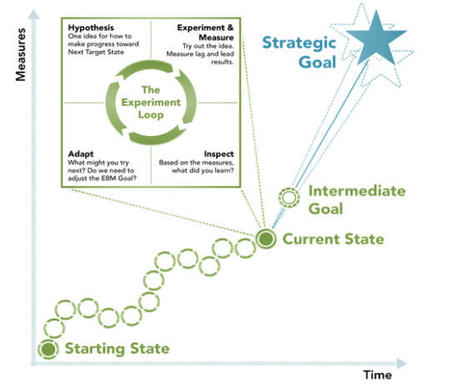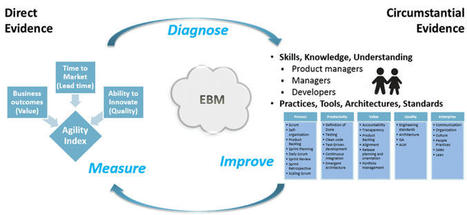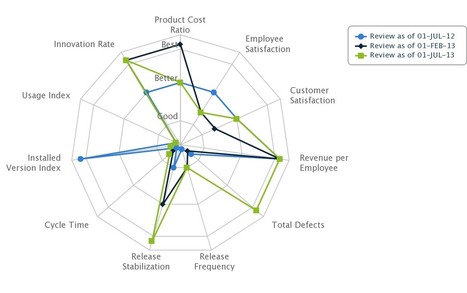 Your new post is loading...
 Your new post is loading...
We've all had challenges with various stakeholders coming to us with a whole bunch of different information and wanting a whole bunch of different things. Who do I listen to? What’s most important? Why do I feel like I’m in a zoo? Some of the most notorious stakeholder animals in the zoo are the HiPPO, the ZEBRA, the WOLF, and the RHINO.
Most of what we do is waste, we just don’t know it yet Microsoft and Amazon are regarded as two of the most successful business organizations in the world today, if not in the entirety of history. And yet, by their own measures, most of their new ideas fail to achieve the goals they set out to achieve. In research spanning more than a decade, Ronny Kohavi found, at Microsoft, the following approximate results:
⅓ of ideas improved their intended measures
⅓ of ideas had no effect on their intended measures
⅓ of ideas actually made their intended measures worse
Or to put it more simply, two-third of ideas had zero or negative business benefit. And it didn’t matter who conceived the ideas; executives and other highly experienced, and usually highly paid individuals had no better track record in devising great ideas than relatively inexperienced and lowly-paid employees. In short, everyone has a bad idea sometimes.
You might be tempted to think that your organization does better than that, but if you’re not measuring the impact of the work that you do, how can you be sure? Perhaps you are luckier than most, but it’s very unlikely. Organizations that measure the impact of their work report largely similar results: most of their ideas fail to improve customer outcomes. The key is to identify the ideas that don’t add value early and not develop them any further.
Are you too busy doing real work to bother about this new fad called "Evidence Based Management"?
We have now launched a new Scrum.org course – Professional Agile Leadership – Evidence-Based Management (EBM), and it is an exceptional occasion to share my experience with implementing the framework.
Gathering the metrics for Evidence-based Management in software organisations can be a strenuous task and I have a number of customers that are fretting on what to collect and from where. Here I try to create an understanding of the ‘what’ that we need to collect.
Updated to reflect the 2020 Scrum Guide!
From my experience and observations, my concern is weak understanding that the Evidence-Based Management (EBM) framework is empirical. It requires transparency, frequent inspection, and adaptation. Some organizations proceed with the initial evaluation and then drop the idea. Measuring once and making some decisions is not enough! No promises that this would work.
This CQ-Dossier provides an introduction into Evidence-based Management (EBM) and how professionals and managers can implement it.
Process the facts from the best sources of information
It's a daunting task to keep up with technology. Consider, for instance, the tremendous increase in the sheer volume of information we are
The central premise of evidence-based practice (EBP) is that decisions are more likely to be successful when they build on critical thinking and the use of the best available evidence – which is easier said than done. In the past decade, leading figures on EBP in Management and Leadership at the Center for Evidence-Based Management (CEBMa) have been developing a framework to make effective people decisions. In short, this comprises a clear decision-making process and skills and techniques to critically evaluate evidence from multiple sources: However, up until now, the debate in the evidence-based management movement was centered more on what is it and why do we need it, than on how you do it. But now we are progressing: several practitioners in organizations are being trained on the principles and know-how to make evidence-based decisions, and interest – and commitment – of professional bodies and organizations is raising.
I will share an interesting case that illustrates the selection bias very well. After that we can take a look at how to counter the selection bias when we make design decisions. Brilliant deduction…
CEBMa is proud to announce the publication of the booklet “Evidence-Based Management, The Basic Principles”. The booklet is written by Denise Rousseau, Rob Briner and Eric Barends and covers basic questions such as “What is EBP?”, “What counts as evidence?”, “Why do we need EBP?”, “What sources of evidence should be considered?”, “Why do we have to critically appraise evidence?” and “What is the evidence for EBP?”. In addition, common misconceptions are discussed.
Durant la 2e guerre mondiale, la Marine a étudié les endroits où renforcer ses avions. Résultats selon leurs données: les ailes, le dos et les ailerons. Mais une personne n'était pas d'accord. Le statisticien disait qu'il fallait plutôt renforcer là où il n'y avait pas eu d'impacts (le nez, les moteurs, le corps). Ses collègues étaient sceptiques: les données montraient l'inverse. Ce qu'il était le seul à avoir compris, c'est que les avions étudiés sont ceux qui revenaient abimés. Ceux touchés ailleurs ne revenaient jamais. Tout mesurer, c'est bien, mais quels sont vos angles morts?
|
La volatilité étant le moteur de l'activité dans un avenir prévisible, les DSI sont dans une position unique pour faire progresser les trois domaines de la composabilité de l'activité : la pensée composable, l'architecture d'entreprise composable et la technologie composable.
Pensée composable
"La composabilité des entreprises n'est pas uniformément élevée dans l'ensemble de l'économie parce qu'elle exige de réinventer la pensée des entreprises", a déclaré M. Sinha. "La pensée traditionnelle des entreprises considère le changement comme un risque, alors que la pensée composable est le moyen de maîtriser le risque d'accélération du changement et de créer une nouvelle valeur commerciale."
Les DSI à la tête d'entreprises à haute composabilité reconnaissent que les conditions commerciales changent souvent, des demandes des clients aux modèles financiers, et donnent aux équipes les plus proches de l'action les moyens de réagir et de se reformer en fonction de ces nouvelles conditions. Par exemple, plus de la moitié des entreprises à forte composabilité ont déclaré promouvoir une culture de confiance élevée qui encourage les employés à prendre des décisions de manière indépendante - soit le double du pourcentage des entreprises à composabilité modérée et six fois plus que les entreprises à faible composabilité.
Architecture d'entreprise composable
Les entreprises de l'ère industrielle étaient conçues pour la stabilité et les changements lents et prévisibles. À l'ère numérique, les architectures d'entreprise doivent être conçues pour l'incertitude et le changement continu. Au lieu d'optimiser l'efficacité, l'entreprise composable optimise l'adaptabilité. Les systèmes, les processus et les travailleurs ne servent plus un cas d'utilisation ou un objectif prédéterminé.
"Les initiatives d'affaires numériques échouent lorsque les chefs d'entreprise commandent des projets à l'organisation informatique et se dérobent ensuite à la responsabilité des résultats de la mise en œuvre, en la traitant comme un projet informatique comme un autre", a déclaré Sinha. "Au lieu de cela, les entreprises à haute composabilité embrassent la responsabilité distribuée des résultats numériques, ce qui reflète un changement que la plupart des DSI essaient de faire depuis plusieurs années, et crée des équipes multidisciplinaires qui mélangent les unités commerciales et informatiques pour obtenir des résultats commerciaux."
Technologie composable
"Les entreprises fonctionnent grâce à la technologie, mais la technologie elle-même doit être composable pour faire fonctionner des entreprises composables", a déclaré M. Sinha. "La composabilité doit s'étendre à toute la pile technologique, de l'infrastructure qui prend en charge l'intégration rapide de nouveaux systèmes et de nouveaux partenaires à la technologie du lieu de travail qui favorise l'échange d'idées."
L'enquête a révélé que les DSI et les responsables technologiques des entreprises à forte composabilité ont poussé plus loin le développement technologique itératif, le partage des données entre les systèmes et les personnes, et le développement des capacités d'intégration des données, des analyses et des applications.
"Les DSI des entreprises à composabilité modérée ou faible doivent internaliser ces trois domaines de la composabilité de l'entreprise pour rendre leur organisation plus agile et bien équipée pour faire face à l'évolution rapide de l'environnement commercial dans lequel elles opèrent", a déclaré M. Sinha. "C'est un processus progressif, mais impératif, à l'horizon 2022 et au-delà."
Source : Gartner
This part I of a three-part series will focus on goals. We’ll examine how the goals set out in the EBM guide correspond to the Scrum Guide and some tools and formats for setting workable goals. Part II will focus on experimentation, and Part III will focus on measurement. This part I of a three-part series will focus on goals. We’ll examine how the goals set out in the EBM guide correspond to the Scrum Guide
To summarize, EBM focuses on empiricism, an appropriate approach for solving complex problems: - We get evidence if we are making progress on reaching the Strategic Goal
- We obtain proof if we focus on the right Strategic – and Intermediate Goals
- An Experiment Loop helps to find out if we create value with Immediate Tactical Goals
- EBM is beneficial both on a portfolio - and product level
- It can be used to match investment to goals and helps to reconsider investment strategies
- It gives you valuable data on whether your budgeting is reasonably aligned
- EBM empowers teams in their self-management and foster organizational alignment
- It fits fine in an agile environment and can be used to increase business agility overall
I was recently asked to speak at ALM Days in Dusseldorf and more specifically to create a talk on Metrics and KPI’s for Quality. As I have been working a lot recently with evidence-based management.
A few weeks ago I headed out to the Scrum.org offices in Boston to participate in training to become an Engagement Manager for Agility Path. I was talking to my father about it when I got back and was surprised that he recognised many of the practices and tools.
Also, remember that “not everything that counts can be counted”, and always consider subjective data in addition to objective data. With all of those caveats, I highly recommend you click on the button at the bottom of the EBM page to download the “EBM Guide” as a PDF, and start measuring today!
Evidence-based management is not a new idea. It has developed several years ago, however, it continued through the movement of evidence-based practice following emerging well-known definition of David Sackett from evidence-based medicine. As other professionals, the movement of evidence-based practice, as well as its application in real setting faces to many challenges. This study aimed to address Evidence-based management definition, principles and its challenges for applying in real settings and the possible solutions to overcome the barriers.
Executives routinely dose their organizations with strategic snake oil: discredited nostrums, partial remedies, or untested management miracle cures. In many cases, the facts about what works are out there—so why don’t managers use them?
Gathering the metrics for Evidence-based Management in software organisations can be a strenuous task and I have a number of customers that are fretting on what to collect and from where. Here I try to create an understanding of the 'what' that we need to collect.
‘Evidence-Based Management’ for software organizations promotes evidence-based decision-making in the managerial domain to create a more sustainable business through improved services in turbulent markets and businesses.
Scrum.org, which has Scrum as its DNA and empiricism as guiding principle, provides guidance for ‘Evidence-Based Management’ for software organizations.
Business wisdom is pretty straightforward, says author and Stanford professor Robert I. Sutton: Act on the best evidence possible, and learn from your mistakes.
Measuring success of agile efforts can be complex. The key is to emphasize value once you’ve established organizational trust.
|
 Your new post is loading...
Your new post is loading...
 Your new post is loading...
Your new post is loading...































Let's start with the HiPPO. The HiPPO is the Highest Paid Person's Opinion. When we look at the HiPPO what they're normally doing is relying on their position to influence people in a certain direction. Notice that it says opinion (everybody has one). What evidence-based management allows us to do is transition that from opinions to facts. So, as we’re learning and getting more information, we’re able to leverage those facts to tell us what we want to invest in next based on the evidence that we have before us. This allows us to look at true data for the investment we are making with small steps, true valid feedback, and therefore disarm the HiPPO.
For the ZEBRA this person normally comes in and has an idea of what they want to do, and they are very strongly leaning in a certain direction. They have Zero Evidence for that direction, But they are Really Arrogant. They just “know” based on “instinct” that what they're proposing is the absolute best thing to do for the organization. What Evidence-Based Management allows us to do is focus on actually getting evidence and reducing where that arrogance comes into play. So instead of it being an arrogance play, we are able to objectively look at the facts and the data that we've learned on our way to achieving a goal.
The WOLF: Working On Latest Fire. How can Evidence-Based Management help us with this? I think there's two ways that Evidence-Based Management helps us with this: one is having a crystal-clear understanding of the goals that we're going after. By having really clear goals, and knowing what is truly most important for our organization, we can say no to the WOLF with the “fires” that happen to come up. We also need to look at the KVAs: the Key Value Areas that are talked about in Evidence-Based Management. By balancing these four areas we can look at ability to innovate or time to market. Those are really important for us to look at because they help balance long-term sustainability along with our desire to provide valuable products now. Too often organizations will be pursuing current value at the expense of things like technical debt or other things that get in the way, that later impact our ability to actually deliver value. So by looking at these two things Evidence-Based Management can help us be proactive and prevent fires, stopping the WOLF in its tracks.
The RHINO. How does the RHINO get impacted by Evidence-Based Management? With Evidence-Based Management what we're doing is focusing on goals. Too often when we have somebody that's Really Here In Name Only what it is, is a lack of motivation, lack of engagement, or a lack of drive for actually accomplishing something meaningful within the organization. Most humans do not have the will or the desire to not do something purposeful. Where Evidence-Based Management can help is to paint a clear direction of what it is that we're trying to accomplish by having clear goals and a trusting environment in which people can succeed. That's going to make it more likely that people are willing to show up and put their hearts and minds into the work that they're doing. Looking at the rest of the KVAs we can also keep in mind what's the environment like? Are there things that we can be doing to help increase employee satisfaction? Often that’s something that gets cut at the expense of shareholder satisfaction or customer satisfaction. But as we all know if we don't have happy employees, we're not going to succeed in the long term with customer satisfaction. So looking at goals and balancing long-term sustainability for our business and our employees can allow the RHINO to show up with their heart and mind.